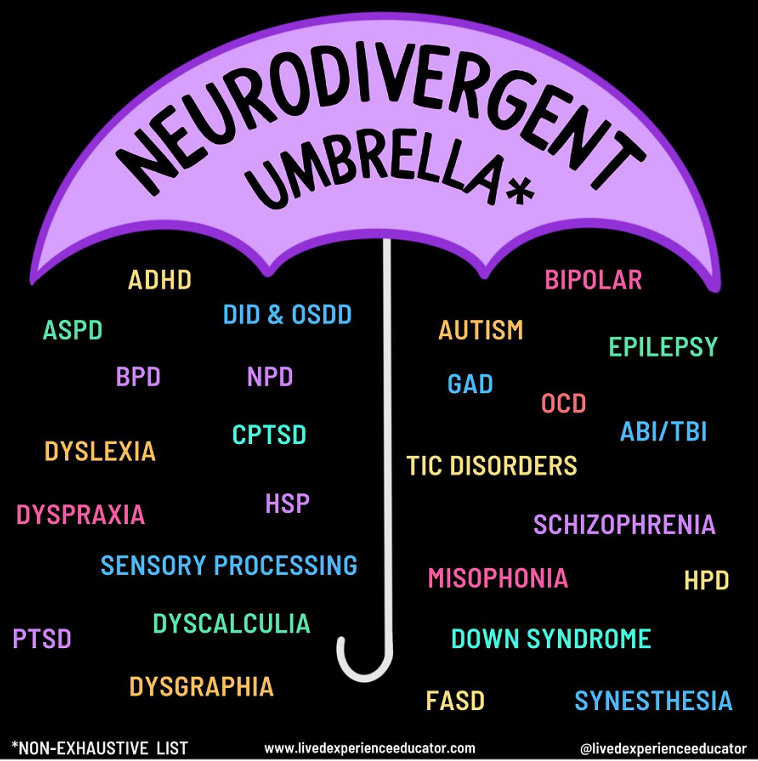Chronic Pain & Neurodivergence: Is There A Link?
Lately, I’ve been hearing a lot about the link between neurodivergence and chronic pain conditions. It seems like more and more I come across people with a diagnosis of ADHD or Autism (or both) who also have hypermobility, Ehlers Danlos or chronic pain conditions. So, is there a link? Does being neurodivergent make you more susceptible to having chronic pain? Let’s look at the research!
Before we dive into the link between neurodivergence and chronic pain, let’s define what exactly neurodivergence means.
What is Neurodivergence?
To be neurodivergent means that you behave, think, or learn differently than someone who is neurotypical. Neurodivergence is a social construct. When talking about behaving typically, we are talking about what is expected of someone in society. There are many conditions that fall under the neurodivergent umbrella.

So why would being neurodivergent make someone more susceptible to chronic pain? Let’s look at the research.
Neurodivergence, Pain, & Hypermobility
This article showed that hypermobility is often associated with one or more neurodevelopmental conditions including autism and ADHD. Children with autism were also shown to have greater mobility in their joints compared to a comparison group. People with Ehlers Danlos are reported to be 7x more likely to be autistic than compared to a control group. How does this relate to pain? Pain is a common symptom for people who are hypermobile. If people who are neurodivergent are more likely to be hypermobile, then we can loosely infer that they are more likely to have chronic pain. In fact this same article showed just that. Participants in the neurodivergent group had higher hypermobility and higher musculoskeletal pain scores. It also showed the higher the hypermobility score, the higher the pain score.
So…if we know pain, hypermobility and neurodivergence are all linked…what should we do?
As someone who may be living with any of these conditions or as a practitioner working with these individuals there are a lot of things you can do to adjust your approach to movement.
- Work on strength in a safe and accessible way
Strength training is important to assist the joints of people with hypermobility (and for everyone, really). However if you are also living with pain it can be hard to get into a strength training routine. It’s important to exercise within your window of tolerance. Work within your window of tolerance to prevent pain flare ups by monitoring the amount of reps you do or the amount of weight you use. Also work within your window of tolerance for the amount of movement you are doing to ensure you are not going into hypermobile ranges of motion. This is when a physiotherapist or other exercise based healthcare worker can be very helpful.
If you’d like more ideas on this topic you can watch my strength training for hypermobility YouTube video or see my last blog post Exercising for EDS and Hypermobility: Ways to Feel Comfortable and Safe with Movement.
- Find safety in the nervous system
We know that pain can cause changes to the nervous system. We also know that people who identify as neurodivergent may have different needs for their nervous systems compared to those who identify as neurotypical. How can you find safety in your nervous system when it comes to movement?
- Choose movements you enjoy and feel comfortable doing
- Find movements that feel safe for both your body and mind
- Choose exercise spaces that feel safe for both your body and mind
- Find people to exercise with that help you feel safe and confident
A calm nervous system can help reduce symptoms of pain and of course make you feel good and more comfortable!
- Go Slow
Remember that movement does not need to be a race. Everyday may feel different. Your body may feel different everyday. If you want to work with your pain and your hypermobility know that you can adjust based on how you are feeling. Long term consistency is more important than big daily gains.
If you feel like you need more one on one support with this and live in British Columbia send me an email so we can see how we can work together at audrianaphysio@gmail.com!
Live anywhere else? My YouTube channel and Instagram have great movement tips!